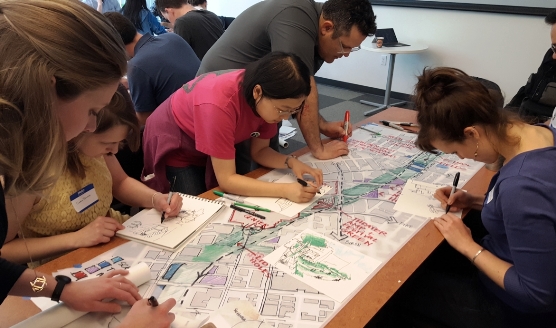
© Scott Bonjukian
The aim of this action is to develop Guidelines that integrate sustainable spatial planning and urban design from the viewpoints of climate change mitigation and adaptation.
In 2019 and 2020, a literature review was conducted on how climate change mitigation and adaptation are taken into account in urban and neighbourhood planning. Based on the review, thematic interviews were carried out in cities of Turku, Hyvinkää and Tampere, with a main objective to identify key successes and challenges in adaptation and mitigation planning. Literature review and interview data were then utilized to create the first draft version of the guidelines. In 2021, more interviews were conducted in different Finnish cities. In addition, virtual co-design workshops were held for various stakeholder groups in the pilot cities of the Canemure-project. In 2022 a guide for urban design will be made and shared.
The work of the sub-project is divided into four actions:
- Collecting and linking R&D relevant results to urban policy practice
- Organization of planning and design charrettes and policy interaction workshops
- Development of guidelines: spatial planning and urban design
- Dissemination of guidelines
The guidance will help cities and other stakeholders to:
- carry out weather and climate risk assessments
- move toward sustainable climate-proof spatial planning and urban design, and
- plan for sustainable urban economic development.
The Guidelines will help practitioners to take into account also sustainable urban development in terms of population density, spatial growth, land use, and building qualities, as well as incorporation of urban ecosystem services in urban planning and design, socially-beneficial allocation of resources in relation to the management of weather and climate-sensitive risks. In integrating mitigation and adaptation in urban planning and design, the Guidelines will also include elements of the sharing economy and implied use of urban space.
The Guidelines will be developed by combining planning and design charrettes (‘charrettes’ are intensive co-creation sessions where citizens, designers and others collaborate on a vision for neighbourhood or city development and agree on specific plans and designs to achieve it), and policy integration workshops, with results and experiences gained in research and development projects.
Time frame
January 2019–September 2024
Current
More information
- Head of Group Thomas Kühn, Finnish Meteorological Institute FMI, firstname.lastname@fmi.fi, tel. +358 50 521 8291